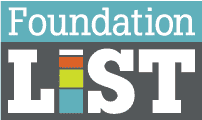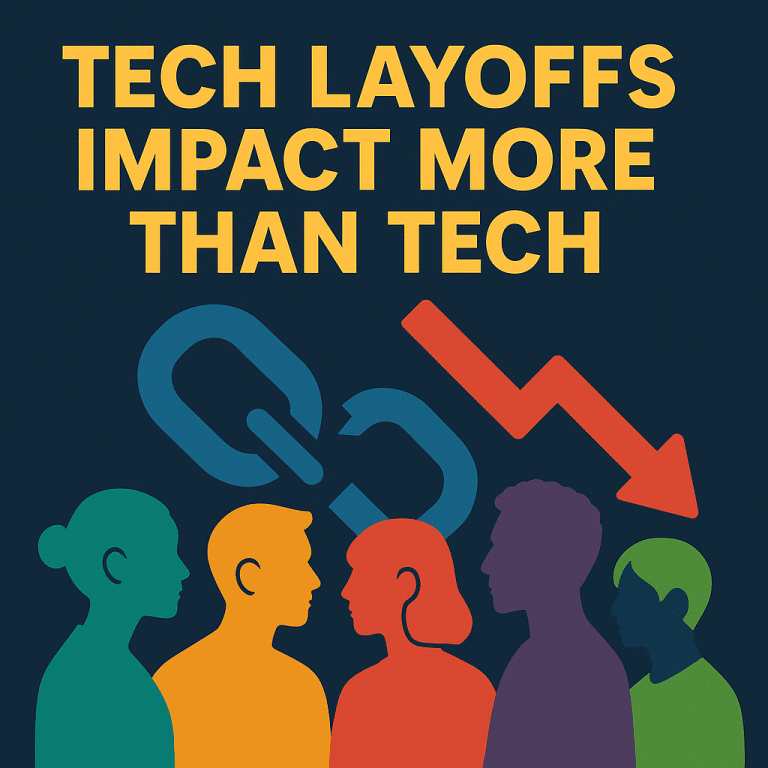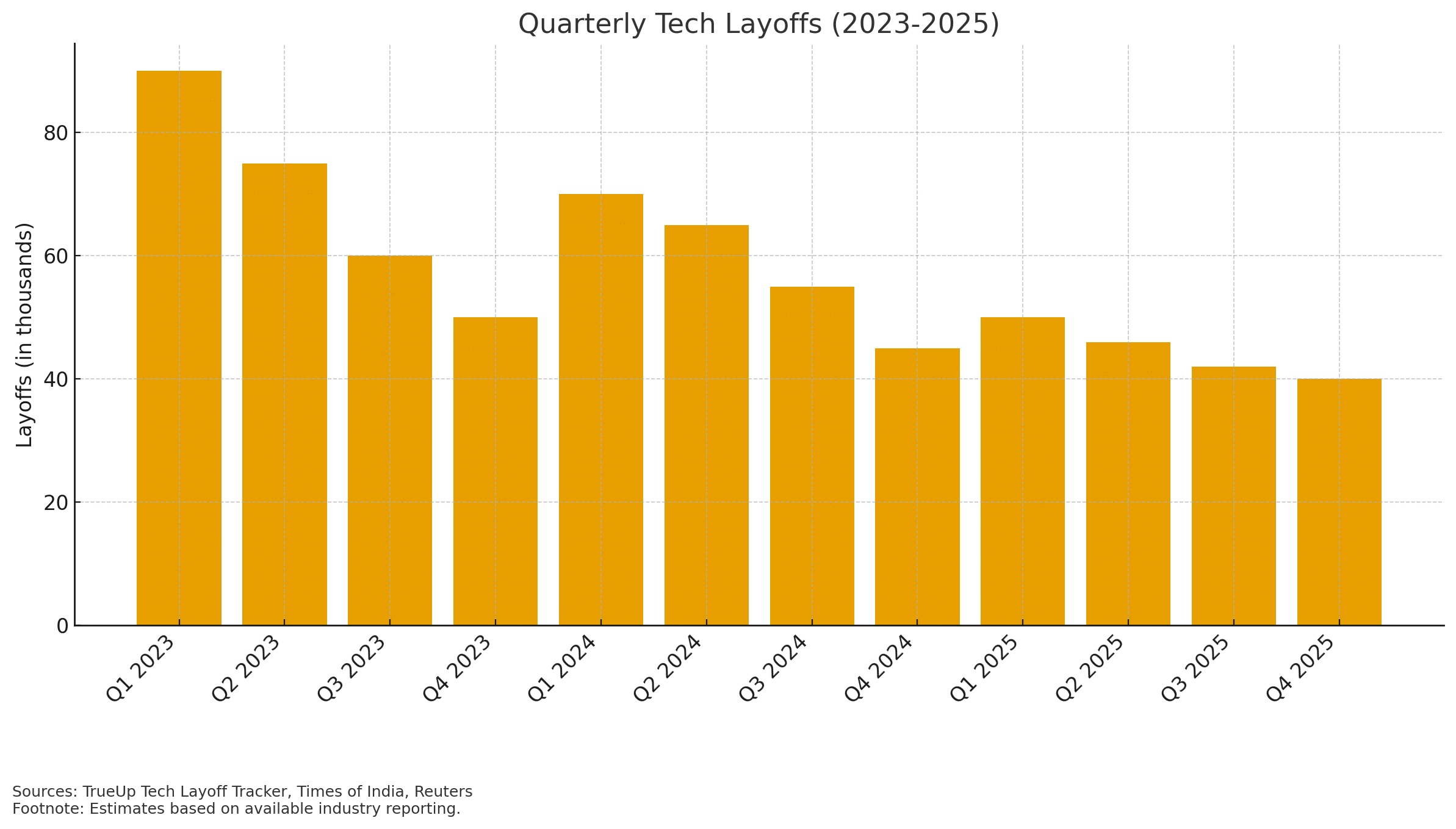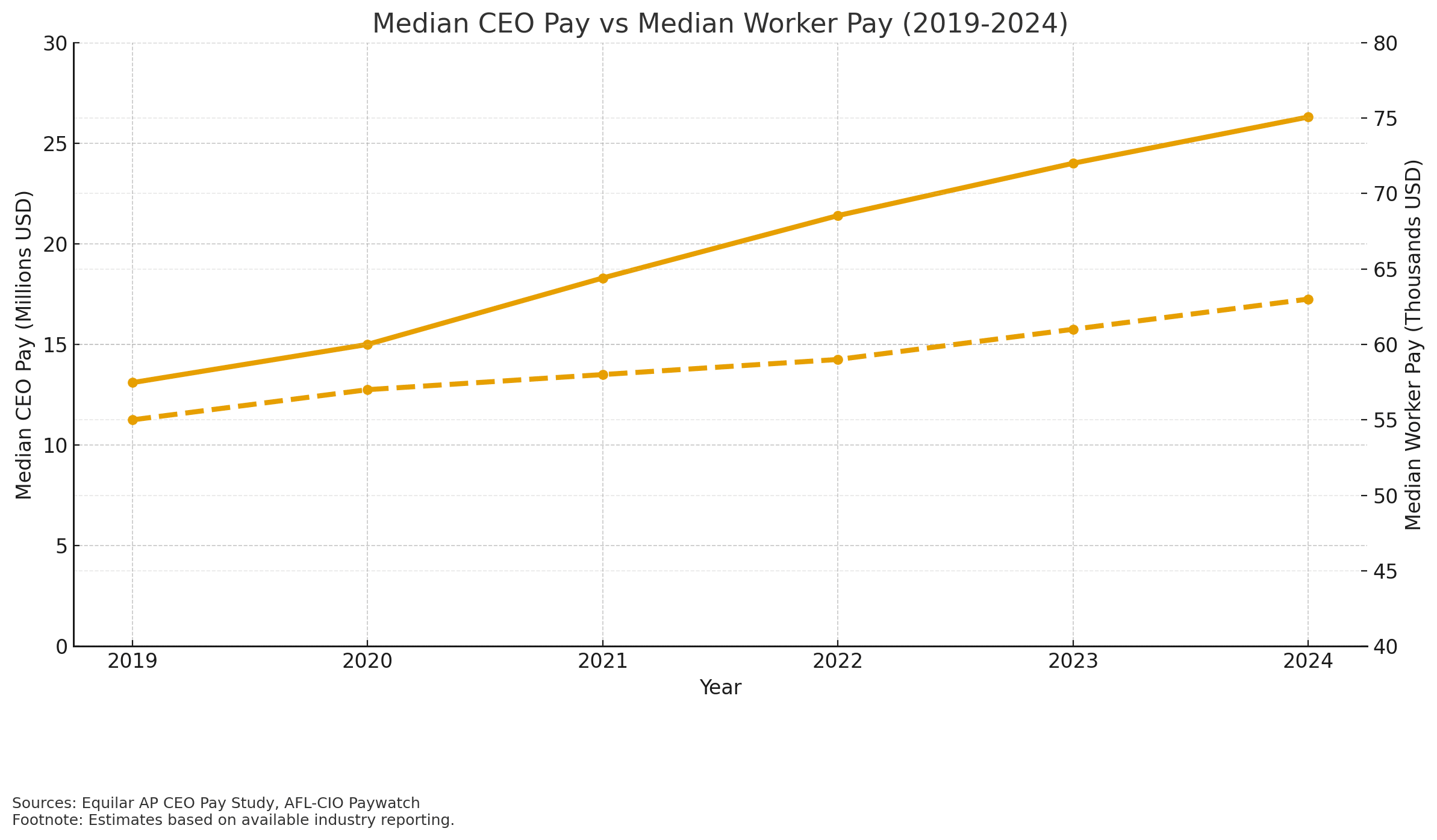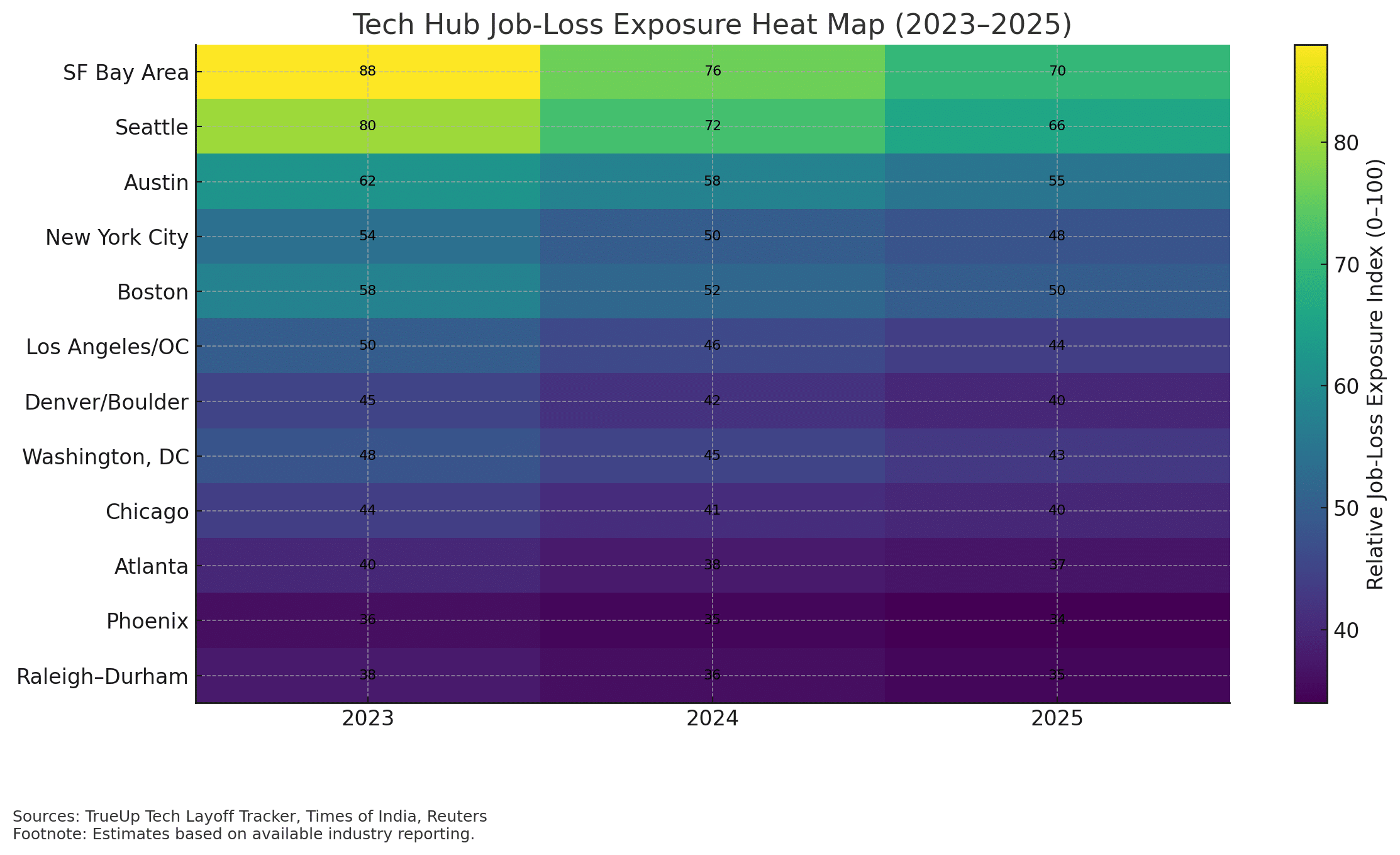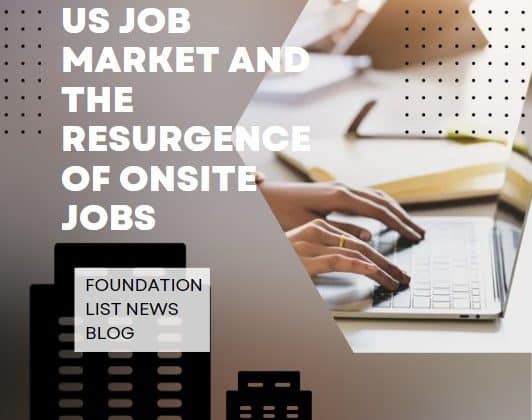Over the past three years, the technology sector has undergone a dramatic transformation. Once celebrated for its ability to create jobs and uplift communities, big tech now seems increasingly driven by shareholder returns rather than workforce investment or innovation. Mass layoffs have hit some of the world’s most profitable companies, even as executive compensation and corporate profitability continue to climb.
In 2025 alone, more than 62,000 jobs have been cut across nearly 300 technology companies in the first five months of the year, with major players like Microsoft, Intel and Amazon among them.¹ In October 2025, Amazon announced it is planning to cut as many as 30,000 corporate-level roles, nearly 10 % of its corporate workforce as part of a cost reduction and AI-driven reorganization.² These layoffs are occurring even as companies report strong financial results.
At the same time, executive compensation has reached new heights. The median total compensation for U.S. S&P 500 CEOs rose to approximately $17.1 million in 2024, up nearly 10 % from the prior year.³ Meanwhile the ratio of CEO pay to median employee pay remains in the range of 285 to one in many companies.⁴ When companies downsize headcount while executive pay rises, it reflects a fundamental shift in corporate strategy: labor is viewed as something to optimize rather than a long-term investment.
The era of lavish perks, free gourmet meals, gym access, generous leave, luxe campuses has dimmed. These perks were once used aggressively to attract engineering talent in a war for skills. But since about 2022, many have vanished or been scaled back as companies focus on cost discipline. Once recruitment is less urgent, many of those amenities disappear.
Artificial intelligence is frequently cited as the rationale for job cuts. The narrative goes: automation and AI transformation enable fewer employees to handle more tasks. But in many cases the numbers suggest cost-reduction and margin improvement are driving the cuts more than actual productivity breakthroughs.⁵ The question facing workers and communities becomes: Is the tech sector accelerating innovation or simply trimming its workforce under the banner of transformation?
These dynamics reverberate beyond corporate offices and stock reports. When large numbers of workers lose skilled employment in tech hubs, the effects ripple outward: local consumer spending drops, tax bases shrink, home values soften, and philanthropic and nonprofit activity can decline. Mission-driven organizations often rely on stable sources of skilled talent, volunteerism, and community giving, all of which may erode under such workforce instability.
Nonprofit organizations face unique pressures. Many depend on partnerships with technology firms for volunteer initiatives, pro-bono services, or programmatic collaboration. Fewer stable tech workers in the region means fewer available partners, fewer donations, and fewer community innovation projects. When a tech company announces mass job cuts, the impact isn’t just on the displaced workers, it hits the ecosystem surrounding them.
A deeper concern lies in innovation itself. Historically the tech sector thrived by reinvesting profits into talent, research and experimentation. That environment required risk-taking, team growth, and patience. But when layoffs become the default operational lever, the culture of innovation suffers. Employees who once had security and room to experiment may retreat into risk-averse behavior.
The challenge for the sector is to rebuild a sustainable social contract: a model where companies can perform financially while also valuing workforce stability, fair wages, and community impact. When a company cuts headcount while rewarding its top executives, it sends a message to employees and to communities: talents are assets only when the market is hot. That message undermines job security, morale, and long-term investment in skills.
Yet there is a hopeful shift. Many professionals departing large tech firms are migrating into the nonprofit sector, civic tech, environmental innovation or mission-driven roles. Their skills aren’t lost, they’re being redirected toward organizations that prioritize purpose alongside profit. This redistribution of talent holds promise for the nonprofit field: access to skilled practitioners, digital know-how, and new partnerships.
For the tech sector to fully deliver on its promise of opportunity, growth and innovation, the emphasis must expand beyond margins and efficiency. Valuing people means building resilient organizations that retain talent, support growth, and engage with community. When corporations view workers as contributors to long-term value not merely costs to reduce, the economy and society both benefit.
To that end, leaders, boards, and stakeholders in both the tech and nonprofit spheres should ask: How does workforce strategy align with community impact? Are layoffs truly driven by new capabilities, or old cost paradigms dressed up as “transformation”? Nonprofit organizations should audit their risk exposure to these tech trends: what happens when local tech employers shrink? How might talent and philanthropic flows shift?
In short, the tech job market is not just a matter of engineers and coders it’s about communities, ecosystems and futures. If value creation is limited to shareholder benefit, and the workforce is treated as optional, the promise of the tech revolution will remain incomplete. Aligning innovative ambition with employment stability, equitable compensation and community contribution is what will make the next chapter of technology sector growth meaningful for everyone.
Tech Layoff Trends
The technology industry may appear dynamic and fast-moving, but beneath the surface major numeric trends are defining its current trajectory. By mid-2025, for example, tracker TrueUp reported that over 96,000 employees in tech had been impacted across 408 layoff events. (See: TrueUp ) Meanwhile the median total compensation for U.S. S&P 500 CEOs rose to $17.1 million in 2024, a 9.7 % increase. (See: Equilar) On the pay-gap front, the average CEO-to-worker pay ratio reached approximately 285-to-1 in 2024. (See: CT Voices)
Worker Experience and Mental Health Impact
It is important to shift from numbers to lived experience. For engineers, product managers and supporting staff, the impact of layoffs is more than a resume update, it can be an identity shake-up, financial strain and emotional burden. When companies reshape themselves in the name of “efficiency,” workers often confront a loss of trust, increased ambiguity about career paths, and anxiety about the future.
Researchers have found that repeated rounds of restructuring can erode morale, raise stress levels and reduce engagement among those who remain. A workforce operating under constant threat of disruption is less likely to stay motivated or innovate freely. For the nonprofit sector this matters: highly skilled tech workers turning to mission-driven roles may carry not just talent but trauma from disruption, requiring organizational empathy, flexible onboarding and roles that rebuild confidence.
A practical takeaway: job-seekers emerging from major tech layoffs should prioritize employers who demonstrate transparent communication, invest in career development and provide psychological safety. For nonprofits looking to hire that talent, offering mentorship, meaningful mission alignment and pathways to influence can help attract displaced professionals seeking stability and purpose.
How Nonprofits Can Respond and Benefit
Nonprofit organizations are uniquely positioned in this moment of tech transition. As highly skilled talent becomes available outside of traditional tech firms, mission-driven organizations can capitalize, but only if they prepare strategically.
Recruit displaced tech talent: Professionals exiting large technology companies often bring expertise in data analytics, AI, product management, cloud operations and user experience. These are precisely the skills many nonprofits need to modernize their programs, scale digitally and drive impact.
Partner on innovation: Rather than seeing layoffs purely as a threat, nonprofits can position themselves as attractors of innovation talent. Building roles around ethical tech, civic data, platform design and community impact gives laid-off workers a meaningful alternative.
Monitor philanthropic and volunteer flows: Workforce disruption in tech hubs can dampen local giving, pro-bono capacity and volunteerism. Nonprofits should assess whether key funders or partnering firms are undergoing headcount reductions and develop contingency plans, such as diversifying donor bases or expanding remote volunteer networks.
Communicate mission-value to hires: For displaced workers who experienced culture shifts in big tech, the promise of “meaning + impact” is increasingly appealing. Nonprofits should emphasize how the role contributes to social good, growth opportunities and community engagement, not just the functional job.
By proactively aligning with the changing labor market, the nonprofit sector can turn disruption into opportunity and build stronger, more resilient operations.
Regional Economic Impacts and Local Community Challenges
Workforce reductions in technology don’t simply affect headquarters offices, they reverberate through local economies. When major firms cut headcount, the consequences extend into housing markets, consumer spending, tax revenue, local services and nonprofit funding ecosystems.
Consider the tech hubs: in cities with dense concentrations of tech employment, job losses mean fewer professionals dining out, fewer startups spun off, reduced philanthropic giving and lower local tax receipts. These changes weaken neighborhood infrastructures, strain public services and erode the very innovation ecosystems that attracted talent in the first place.
For nonprofits operating in those regions, awareness of local economic risk is critical. A formerly robust donor base may shrink when corporate bonus pools vanish. Volunteer recruitment could falter if professional networks are in flux. Boards and funders may reduce grant allocations in response to wider corporate belt-tightening.
Nonprofits should map their exposure to local tech layoffs, monitor real-estate and consumption trends in their region, and engage proactively with affected professionals and companies to maintain continuity of service and funding.
Historical Context: Boom-and-Bust Hiring Cycles in Tech
To fully understand current conditions, it is helpful to view them in historical context. The tech industry has long experienced boom-and-bust cycles: rapid hiring during expansion periods followed by sharp corrections when demand normalizes or economic conditions shift.
For example, post-dot-com, many companies scaled aggressively then retrenched when realities failed to match promise. Similarly, the pandemic era saw abrupt expansions in tech workforce driven by remote work and e-commerce demand, followed by compressions as growth normalized. The current wave of layoffs in 2024-25 echoes that pattern, but with a twist: the dominant narrative is now about margin optimization and AI investment rather than only cyclical over-hiring.
By examining previous cycles, workforce strategists and nonprofits can better anticipate risk: ask whether firms are scaling sustainably, whether hiring is driven by long-term investment or short-term gain, and whether community ecosystems are supportive of durability or just boom-driven expansion.
AI Reality Check: Which Jobs Are Truly Vulnerable
When companies cite “automation” or “AI transformation” as reasons for workforce reduction, affected workers and nonprofits need clarity about what that really means.
Vulnerable roles tend to include repetitive or standardized tasks: certain back-office functions, middle-management layers, data-entry heavy operations and roles with clearly defined inputs/outputs. If AI can replicate or augment these reliably, organizations may restructure.
Less vulnerable roles include those requiring human judgement, cross-functional collaboration, qualitative nuance, creativity, stakeholder engagement and domain-specific expertise. These are harder to automate and more likely to grow in importance.
Emerging opportunity areas: As companies invest in AI infrastructure, cloud platforms, ethical-AI governance, responsible data-design, community UX, civic tech, digital inclusion and human-machine partnerships, new roles are forming. For nonprofits, this signals an opportunity to attract talent who want to transition into mission-driven applications of these disciplines.
Thus, job-seekers should assess whether their role is automation-at-risk or automation-adjacent. Nonprofits should craft roles that leverage unique human skills and frame them around purpose, not just cost-reduction.
Policymaker and Public Perspective
The changes in tech employment raise broader questions of public policy, corporate governance and social responsibility.
Pay transparency and ratios: Reports show that among large U.S. firms, the median CEO-worker pay ratio in 2024 was about 192-to-1 at S&P 500 companies. (see: Harvard Law Corporate Governance Forum) The higher ratios fuel public concern, with increasing calls for policy responses such as greater disclosure, pay-cap proposals and alignment of executive rewards with workforce outcomes.
Workforce retraining & transition support: As structural job shifts accelerate, policy initiatives around adult education, retraining subsidies, portable benefits and labor market supports become more relevant. Nonprofit organizations can play a role in linking displaced tech workers to transition services and mission-driven opportunities.
Corporate governance: Boards and investors are increasingly challenged to consider stakeholder impacts beyond short-term profit. Metrics such as workforce stability, community impact, and talent investment are gaining traction in ESG frameworks. For nonprofits, awareness of these developments helps frame partnership dialogues with corporate employers undergoing change.
In this broader context, the tech labor shift is not only an employment story: it is a governance, regulatory and societal story.
Calls for Ethical Leadership and ESG Alignment
With workforce shifts and cost-cutting dominating narratives, there is an urgent need for leadership that balances profitability with purpose. Ethical leadership in tech means asking: how will our decisions affect our workforce, our communities and our long-term innovation capacity?
Companies that retain employees during rebuilds, invest in upskilling, promote transparent communication, and consider community partnerships become more resilient. For nonprofits, engaging with corporate partners who reflect these values creates stronger outcomes.
If innovation is genuinely about human empowerment, it should not require replacing talented individuals with cost-reducing automation alone. When companies prioritize stewardship of people, technology becomes part of the solution, not simply a lever for cutting costs. Nonprofits can amplify these values by highlighting them in procurement, partnerships and employer branding.
How Job Seekers Can Navigate the Shift (Tech Layoffs)
For tech professionals (and those preparing to pivot into tech related roles) the current environment demands strategy, adaptability and mission-alignment.
Assess your role’s risk: Is the function easily automated? Is the company redirecting resources toward AI infrastructure? If the answers lean toward “yes,” proactive planning is wise.
Build transferable skills: Data literacy, cloud competence, machine-learning awareness, product design, human-centered UX, digital transformation experience all retain value. Combining those with purpose-driven frameworks (for nonprofits, social good, impact measurement) strengthens your market position.
Explore nonprofit and mission-driven roles: Many displaced professionals are choosing careers in health tech, civic data, environmental innovation or nonprofit leadership. These sectors value both deep domain expertise and mission integrity.
Highlight adaptability and learning mindset: Demonstrate that you can thrive through disruption. Nonprofits and forward-thinking tech employers value candidates who bring curiosity, resilience and capacity to pivot.
Evaluate employer culture and stability: Look for organizations that invest in talent, communicate clearly, prioritize growth not cost-only metrics, and have a strong purpose. Compensation is necessary, but it is not the sole signal. Work that offers agency, growth and mission can offer greater long-term stability.
In sum: the current market marks transition, not termination. The skills you build and how you frame your value matter more than ever.
Reflection on Shared Prosperity
The promise of the technology age was not only about faster processing, global connectivity and new products, it was about opportunity, inclusion and uplift. When the sector emphasizes efficiency and cost-reduction alone, that promise risks falling short.
But the story does not have to end there. By aligning innovation with workforce stability, equitable compensation and community engagement, the tech sector can deliver broader prosperity. For nonprofits, this moment is not just a challenge, it is a calling to engage, recruit, partner and lead.
It is in this alignment of purpose and performance that we can move from a tech job market defined by disruption to one defined by contribution, building organizations that serve not only shareholders, but society.
Footnotes
-
Layoffs in 2025: Over 62,000 employees laid off in first five months at 284 tech companies. Times of India. June 5, 2025.
-
Amazon targets as many as 30,000 corporate job cuts. Reuters. October 27, 2025. Reuters
-
Median U.S. CEO pay rose to $17.1 million in 2024. Associated Press / Reuters. April 24, 2025. Reuters
-
CEO-to-worker pay gap climbs to 285:1. AFL-CIO Executive Paywatch. July 31, 2025. NW Labor Press
-
Study: layoffs often cost-cutting rather than pure automation productivity gains. Fast Company (analysis). ChiefExecutive.net
